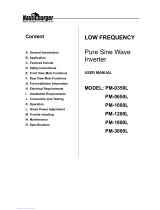
Page viii
© 2016 Sensata Technologies
List of Figures
Figure 1-1, Power Switch, Status LED, and Accessory Connection Ports ................................. 3
Figure 1-2, Electrical Connection Points ............................................................................ 4
Figure 1-3, Left Side Features (MS2012, MS2812, MS2024, MS4024, MS4048) ...................... 5
Figure 1-4, Left Side Features (MS2000 Series) ................................................................. 6
Figure 2-1, Simplifi ed Installation for Permanent Installations (MS Series) ............................. 8
Figure 2-2, Simplifi ed Installation for Permanent Installations (MS2000) ............................... 9
Figure 2-3, Approved Mounting Positions ........................................................................ 11
Figure 2-4, MS Dimensions (MS2012, MS2812, MS2024, MS4024, MS4048) ........................ 12
Figure 2-5, MS Dimensions (MS2000) ............................................................................ 13
Figure 2-6, DC and Battery Temperature Sensor Wiring .................................................... 16
Figure 2-7, Battery Hardware Installation ....................................................................... 19
Figure 2-8, Inverter DC Hardware Installation ................................................................. 19
Figure 2-9, Battery Temperature Sensor ......................................................................... 20
Figure 2-10, AC Terminal Block ...................................................................................... 23
Figure 2-11, AC Wiring for Single In – Single Out (30 A) Confi gurations .............................. 26
Figure 2-12, AC Wiring for Single In – Single Out (60 A) Confi gurations .............................. 27
Figure 2-13, AC Wiring for Single In – Dual Out Confi gurations .......................................... 28
Figure 2-14, AC Wiring for Dual In – Single Out Confi gurations .......................................... 29
Figure 2-15, AC Wiring for Dual In – Dual Out Confi gurations ............................................ 30
Figure 2-16, AC Wiring for MS2000 Models ..................................................................... 33
Figure 2-17, AC Wiring for MS2000-15B/-20B Models ....................................................... 34
Figure 2-18, Grounding System for MS Series ................................................................. 35
Figure
2-19, Multiple Connections to DC Ground Rod (Method 1) ........................................ 36
Figure 2-20, Multiple Connections to DC Ground Rod (Method 2) ........................................ 37
Figure 2-21, Single Connection to DC Ground Rod (Method 3) ........................................... 37
Figure 2-22, Neutral-to-Ground Connection (Inverter Mode) .............................................. 40
Figure 2-23, Neutral-to-Ground Connection (Standby Mode) .............................................. 40
Figure 2-24, Disconnecting the Neutral-to-Ground Connection ........................................... 41
Figure 2-25, Connecting a Large DC Ground Wire ............................................................ 41
Figure 2-26, Warning Label ........................................................................................... 42
Figure 2-27, AC Voltage Checks ..................................................................................... 44
Figure 2-28, AC Voltage Checks (MS2000 models) ........................................................... 44
Figure 2-29, AC Voltage Checks (MS2000-15B/20B models) .............................................. 44
Figure 3-1, Power Flow – Inverter Mode (MS2012/2812/2024/4024/4048) .......................... 45
Figure 3-2, Power Flow – Inverter Mode (MS2000 models) ................................................ 46
Figure 3-3, Power Flow – Inverter Mode (MS2000-15B/-20B models) .................................. 46
Figure 3-4, Power Flow – Standby Mode (MS2012/2812/2024/4024/4048) .......................... 47
Figure 3-5, Power Flow – Standby Mode (MS2000 models) ................................................ 47
Figure 3-6, Power Flow – Standby Mode (MS2000-15B/-20B models) ................................. 48
Figure 3-7, Automatic 4-Stage Charging Graph ................................................................ 49
Figure 3-8, BTS Temperature to Charge Voltage Change ................................................... 50
Figure 3-9, Power Switch and Status Indicator ................................................................. 52
Figure 4-1, Performing an Inverter Reset ........................................................................ 57
Figure A-1, MS Series Effi ciency Chart ............................................................................ 59
Figure A-2, MS Series VAC Input to Charge Amps ............................................................ 59
Figure A-3, Temperature to Continuous Inverter Output Power ........................................... 60
Figure A-4, Temperature to Continuous Charger Output Current ......................................... 60



























